ESP MERCEDES-BENZ METRIS 2020 MY20 Operator’s Manual
[x] Cancel search | Manufacturer: MERCEDES-BENZ, Model Year: 2020, Model line: METRIS, Model: MERCEDES-BENZ METRIS 2020Pages: 320, PDF Size: 26.38 MB
Page 37 of 320
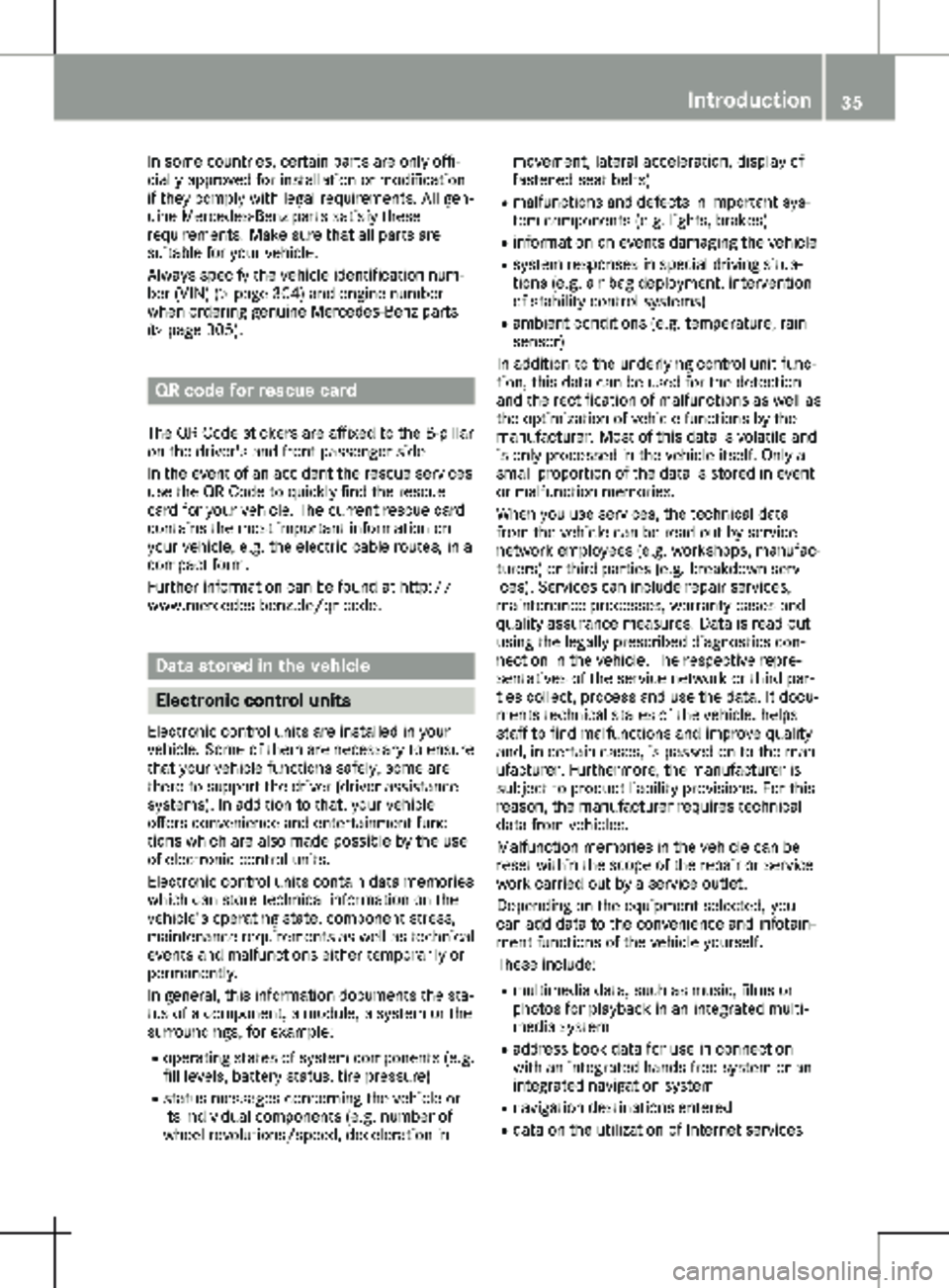
In some countries, certain parts are only offi-
cially approved for installation or modification
if they comply with legal requirements. All gen-
uine Mercedes-Benz parts satisfy these
requirements. Make sure that all parts are
suitable for your vehicle.
Always specify the vehicle identification num-
ber (VIN) ( Y page
304) and engine number
when ordering genuine Mercedes-Benz parts
(Y page 305). QR code for rescue card
The QR Code stickers are affixed to the B-pillar
on the driver's and front-passenger side.
In the event of an accident the rescue services
use the QR Code to quickly find the rescue
card for your vehicle. The current rescue card
contains the most important information on
your vehicle, e.g. the electric cable routes, in a
compact form.
Further information can be found at http://
www.mercedes-benz.de/qr-code. Data stored in the vehicle
Electronic control units
Electronic control units are installed in your
vehicle. Some of them are necessary to ensure
that your vehicle functions safely, some are
there to support the driver (driver assistance
systems). In addition to that, your vehicle
offers convenience and entertainment func-
tions which are also made possible by the use
of electronic control units.
Electronic control units contain data memories
which can store technical information on the
vehicle's operating state, component stress,
maintenance requirements as well as technical
events and malfunctions either temporarily or
permanently.
In general, this information documents the sta-
tus of a component, a module, a system or the
surroundings, for example:
R operating states of system components (e.g.
fill levels, battery status, tire pressure)
R status messages concerning the vehicle or
its individual components (e.g. number of
wheel revolutions/speed, deceleration in movement, lateral acceleration, display of
fastened seat belts)
R malfunctions and defects in important sys-
tem components (e.g. lights, brakes)
R information on events damaging the vehicle
R system responses in special driving situa-
tions (e.g. air bag deployment, intervention
of stability control systems)
R ambient conditions (e.g. temperature, rain
sensor)
In addition to the underlying control unit func-
tion, this data can be used for the detection
and the rectification of malfunctions as well as
the optimization of vehicle functions by the
manufacturer. Most of this data is volatile and
is only processed in the vehicle itself. Only a
small proportion of the data is stored in event
or malfunction memories.
When you use services, the technical data
from the vehicle can be read out by service
network employees (e.g. workshops, manufac-
turers) or third parties (e.g. breakdown serv-
ices). Services can include repair services,
maintenance processes, warranty cases and
quality assurance measures. Data is read out
using the legally prescribed diagnostics con-
nection in the vehicle. The respective repre-
sentatives of the service network or third par-
ties collect, process and use the data. It docu-
ments technical states of the vehicle, helps
staff to find malfunctions and improve quality
and, in certain cases, is passed on to the man-
ufacturer. Furthermore, the manufacturer is
subject to product liability provisions. For this
reason, the manufacturer requires technical
data from vehicles.
Malfunction memories in the vehicle can be
reset within the scope of the repair or service
work carried out by a service outlet.
Depending on the equipment selected, you
can add data to the convenience and infotain-
ment functions of the vehicle yourself.
These include:
R multimedia data, such as music, films or
photos for playback in an integrated multi-
media system
R address book data for use in connection
with an integrated hands-free system or an
integrated navigation system
R navigation destinations entered
R data on the utilization of Internet services Introduction
35 Z
Page 38 of 320
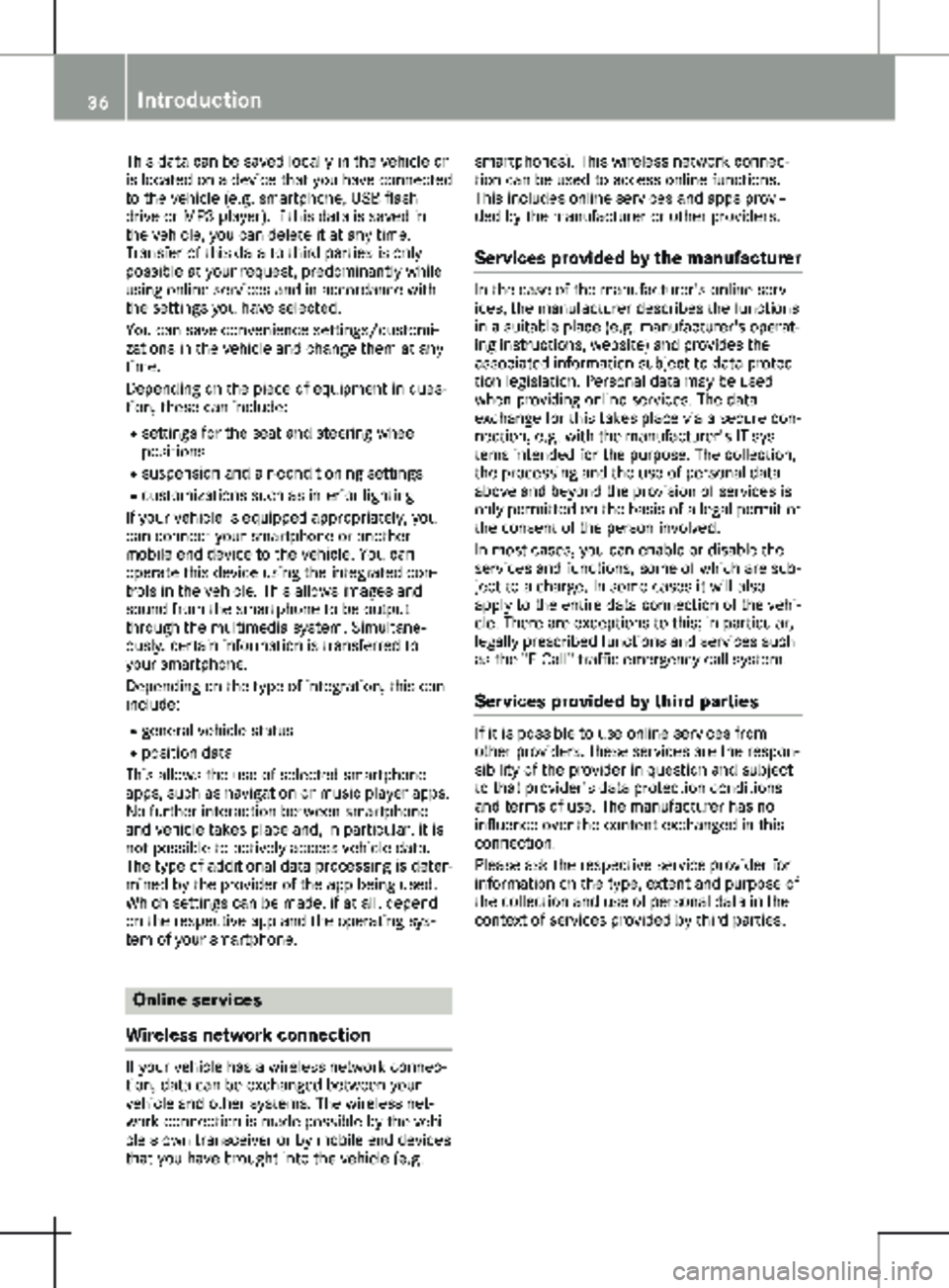
This data can be saved locally in the vehicle or
is located on a device that you have connected
to the vehicle (e.g. smartphone, USB flash
drive or MP3 player). If this data is saved in
the vehicle, you can delete it at any time.
Transfer of this data to third parties is only
possible at your request, predominantly while
using online services and in accordance with
the settings you have selected.
You can save convenience settings/customi-
zations in the vehicle and change them at any
time.
Depending on the piece of equipment in ques-
tion, these can include:
R settings for the seat and steering wheel
positions
R suspension and air-conditioning settings
R customizations such as interior lighting
If your vehicle is equipped appropriately, you
can connect your smartphone or another
mobile end device to the vehicle. You can
operate this device using the integrated con-
trols in the vehicle. This allows images and
sound from the smartphone to be output
through the multimedia system. Simultane-
ously, certain information is transferred to
your smartphone.
Depending on the type of integration, this can
include:
R general vehicle status
R position data
This allows the use of selected smartphone
apps, such as navigation or music player apps.
No further interaction between smartphone
and vehicle takes place and, in particular, it is
not possible to actively access vehicle data.
The type of additional data processing is deter-
mined by the provider of the app being used.
Which settings can be made, if at all, depend
on the respective app and the operating sys-
tem of your smartphone. Online services
Wireless network connection If your vehicle has a wireless network connec-
tion, data can be exchanged between your
vehicle and other systems. The wireless net-
work connection is made possible by the vehi-
cle's own transceiver or by mobile end devices
that you have brought into the vehicle (e.g. smartphones). This wireless network connec-
tion can be used to access online functions.
This includes online services and apps provi-
ded by the manufacturer or other providers.
Services provided by the manufacturer In the case of the manufacturer's online serv-
ices, the manufacturer describes the functions
in a suitable place (e.g. manufacturer's operat-
ing instructions, website) and provides the
associated information subject to data protec-
tion legislation. Personal data may be used
when providing online services. The data
exchange for this takes place via a secure con-
nection, e.g. with the manufacturer's IT sys-
tems intended for the purpose. The collection,
the processing and the use of personal data
above and beyond the provision of services is
only permitted on the basis of a legal permit or
the consent of the person involved.
In most cases, you can enable or disable the
services and functions, some of which are sub-
ject to a charge. In some cases it will also
apply to the entire data connection of the vehi-
cle. There are exceptions to this; in particular,
legally prescribed functions and services such
as the "E-Call" traffic emergency call system.
Services provided by third parties If it is possible to use online services from
other providers, these services are the respon-
sibility of the provider in question and subject
to that provider's data protection conditions
and terms of use. The manufacturer has no
influence over the content exchanged in this
connection.
Please ask the respective service provider for
information on the type, extent and purpose of
the collection and use of personal data in the
context of services provided by third parties.36
Introduction
Page 41 of 320
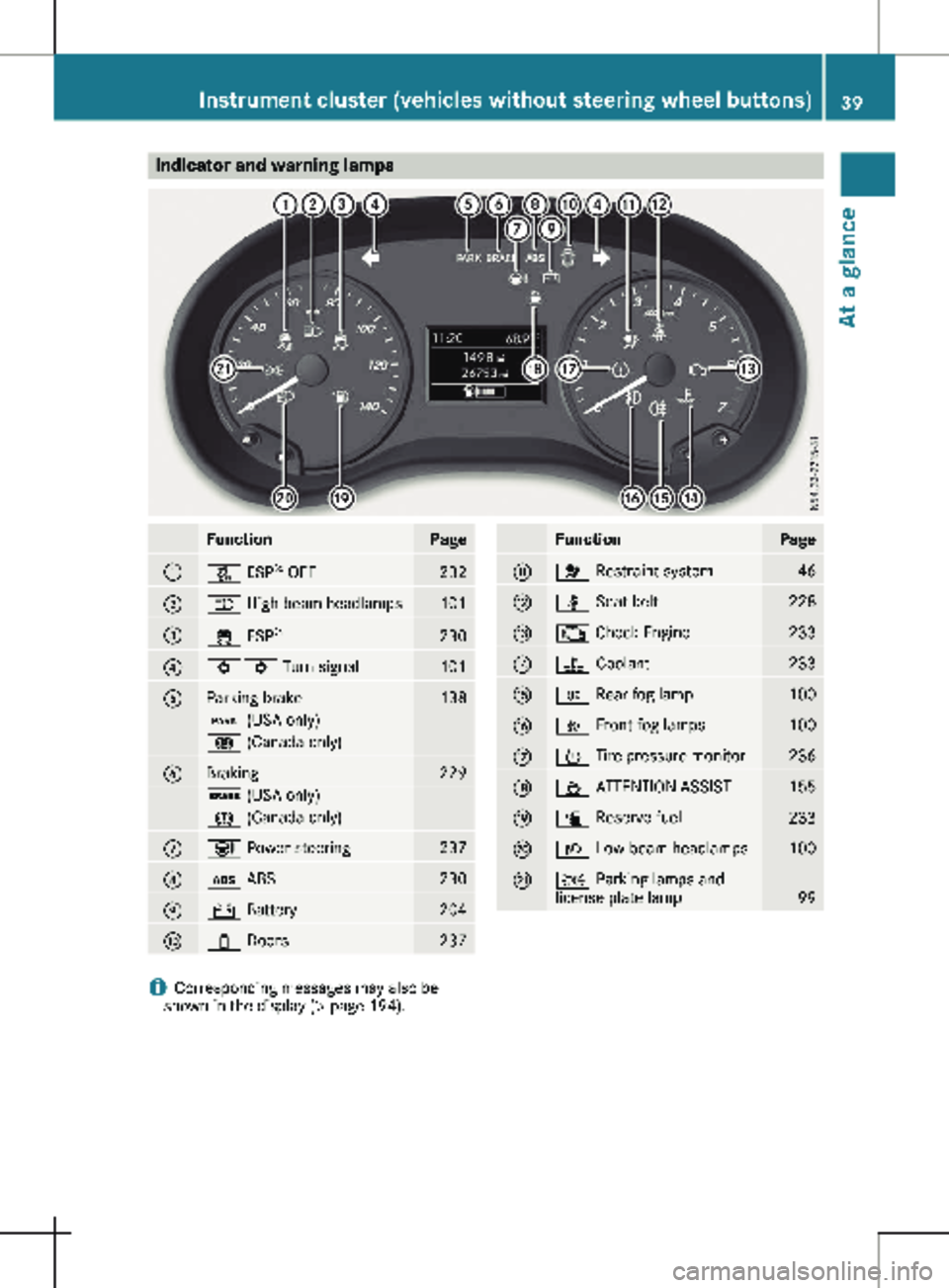
Indicator and warning lamps
Function Page
:
å ESP
®
OFF 232
;
K High-beam headlamps
101
=
÷ ESP
® 230
?
#! Turn signal
101
A
Parking brake 138
F (USA only)
! (Canada only)
B
Braking 229
$ (USA only)
J (Canada only)
C
Ð Power steering
237
D
ò ABS
230
E
# Battery
204
F
1 Doors
237 Function Page
G
6 Restraint system
46
H
ü Seat belt
228
I
; Check Engine
233
J
? Coolant
233
K
R Rear fog lamp
100
L
O Front fog lamps
100
M
h Tire pressure monitor
236
N
À ATTENTION ASSIST
155
O
æ Reserve fuel
233
P
L Low-beam headlamps
100
Q
T Parking lamps and
license plate lamp
99
i
Corresponding messages may also be
shown in the display (Y page 194).Instrument cluster (vehicles without steering wheel buttons)
39
At a glance
Page 43 of 320
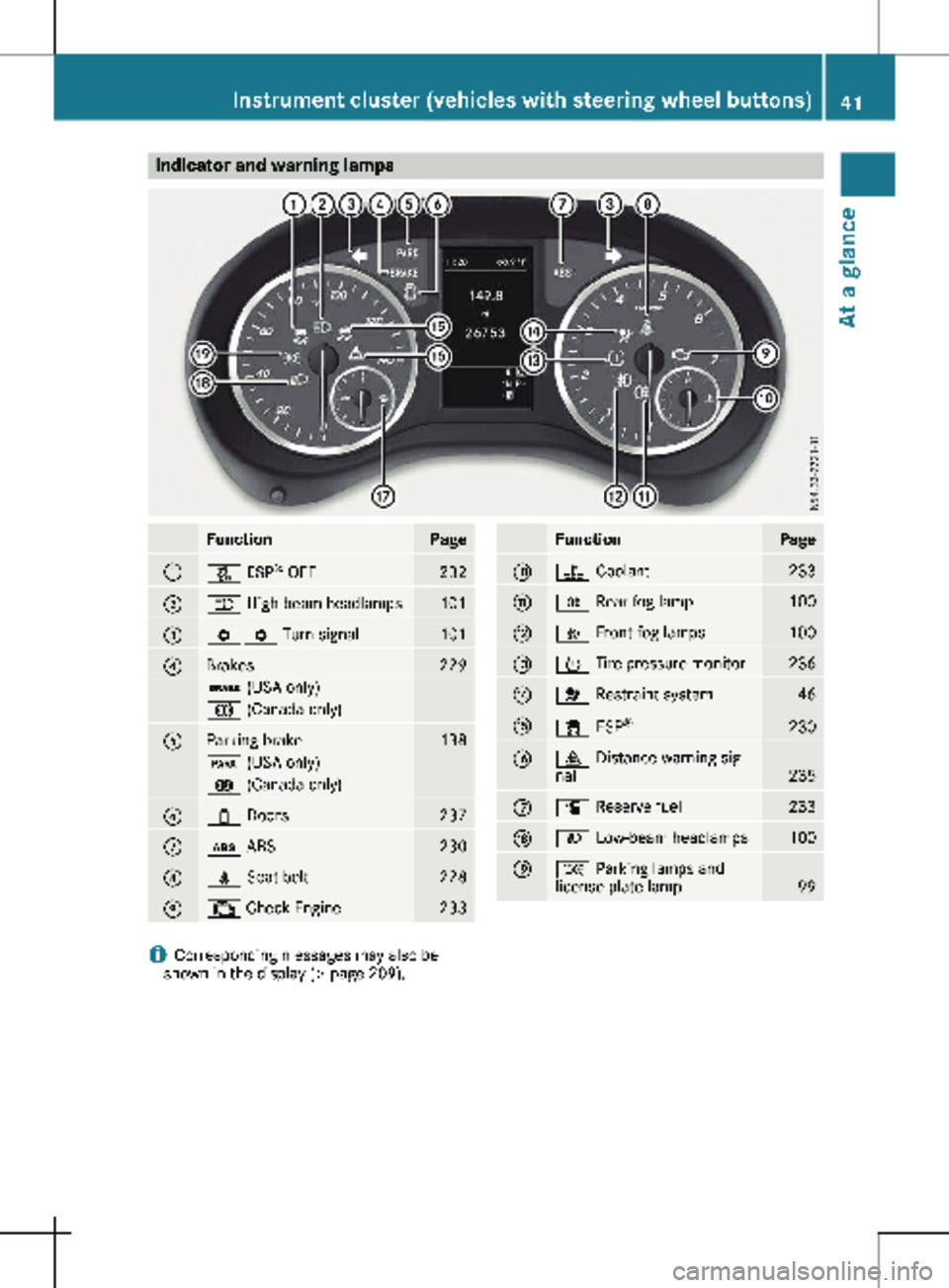
Indicator and warning lamps
Function Page
:
å ESP
®
OFF 232
;
K High-beam headlamps
101
=
#! Turn signal
101
?
Brakes 229
$ (USA only)
J (Canada only)
A
Parking brake 138
F (USA only)
! (Canada only)
B
1 Doors
237
C
ò ABS
230
D
ü Seat belt
228
E
; Check Engine
233 Function Page
F
? Coolant
233
G
R Rear fog lamp
100
H
O Front fog lamps
100
I
h Tire pressure monitor
236
J
6 Restraint system
46
K
÷ ESP
® 230
L
· Distance warning sig-
nal
235
M
æ Reserve fuel
233
N
L Low-beam headlamps
100
O
T Parking lamps and
license plate lamp
99
i
Corresponding messages may also be
shown in the display (Y page 209).Instrument cluster (vehicles with steering wheel buttons)
41
At a glance
Page 45 of 320
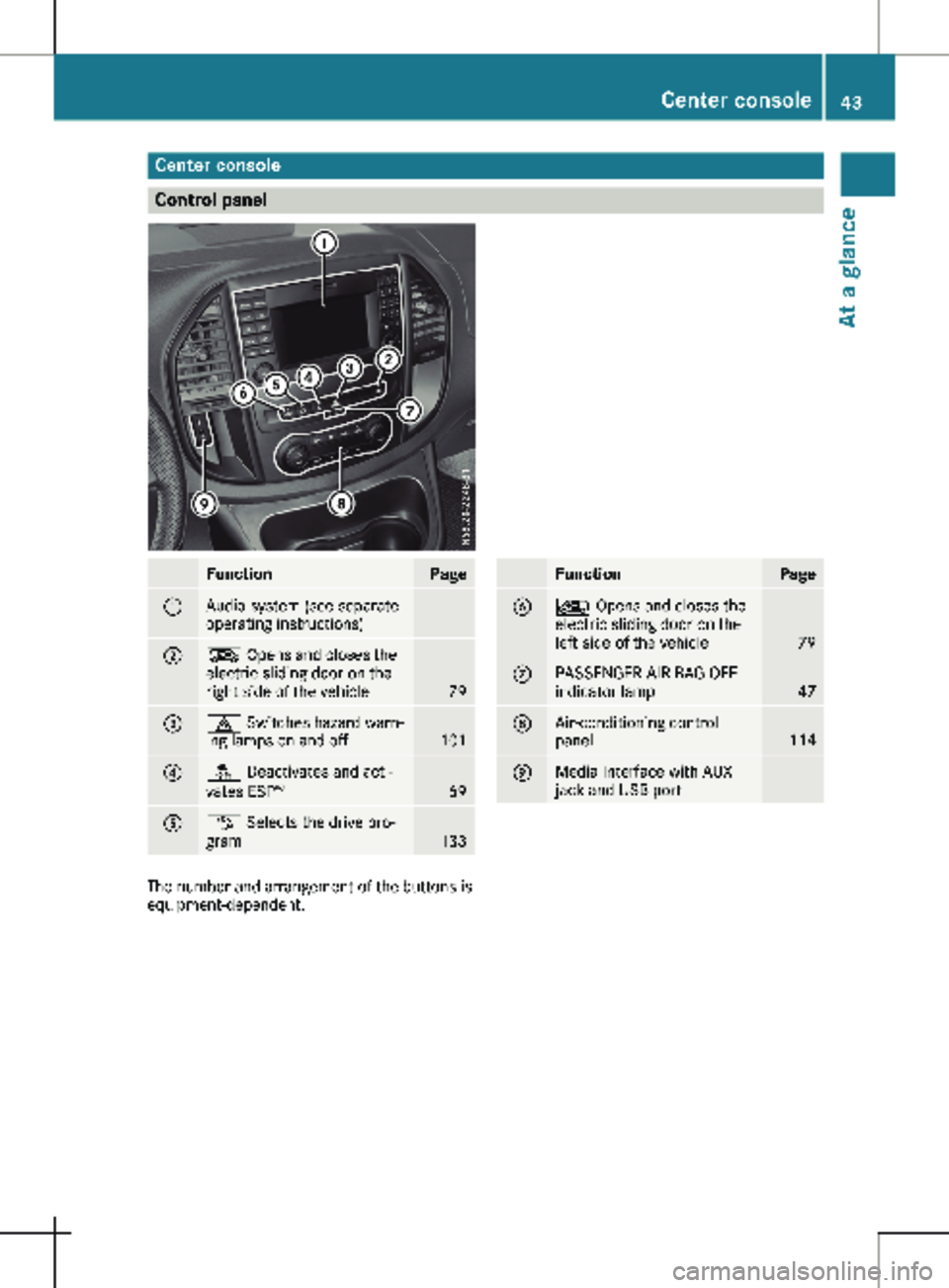
Center console
Control panel
Function Page
:
Audio system (see separate
operating instructions)
;
Æ Opens and closes the
electric sliding door on the
right side of the vehicle
79
=
£ Switches hazard warn-
ing lamps on and off
101
?
å Deactivates and acti-
vates ESP
® 69
A
É Selects the drive pro-
gram
133 Function Page
B
Å Opens and closes the
electric sliding door on the
left side of the vehicle
79
C
PASSENGER AIR BAG OFF
indicator lamp
47
D
Air-conditioning control
panel
114
E
Media Interface with AUX
jack and USB port
The number and arrangement of the buttons is
equipment-dependent. Center console
43At a glance
Page 49 of 320

A malfunction has occurred if the
6
restraint system warning lamp:
R does not light up after the ignition is
switched on
R does not go out after a few seconds with the
engine running
R lights up again while the engine is running G
WARNING
If the restraint system is malfunctioning,
restraint system components may be trig-
gered unintentionally or may not be trig-
gered as intended in the event of an acci-
dent. This may affect the Emergency Ten-
sioning Devices or air bags, for example.
There is a risk of injury.
Have the restraint system checked and
repaired immediately at a qualified specialist
workshop. PASSENGER AIR BAG OFF indicator
lamp
PASSENGER AIR BAG OFF indicator lamp
: is
part of the Occupant Classification System
(OCS).
The PASSENGER AIR BAG OFF indicator lamp
informs you about the status of the co-driver's
air bag.
If the PASSENGER AIR BAG OFF indicator
lamp:
R is lit, the co-driver's air bag is deactivated.
It will not be deployed in the event of an
accident.
R is not lit , the co-driver's air bag is enabled.
If, in the event of an accident, all deploy-
ment criteria are met, the co-driver's air bag
is deployed. Depending on the person in the co-driver's
seat, the co-driver's air bag must be either
deactivated or enabled; see the following
points. You must make sure of this both
before and during a journey.
R Children in a child restraint system:
whether the co-driver's air bag is enabled or
deactivated depends on the installed child
restraint system and the age and size of the
child. It is thus essential to comply with the
instructions on the "Occupant Classification
System (OCS)" ( Y page
54) and "Children
in the vehicle" ( Y page 60). Information is
also included here on rearward or forward-
facing child restraint systems on the co-driv-
er's seat.
R All other persons: depending on the classi-
fication of the person in the co-driver's seat,
the co-driver's air bag must be either ena-
bled or deactivated (Y page 54). Be sure to observe the notes on "Seat belts"
( Y page 47) and "Air bags" (Y page 51).
Information is also included here on the cor-
rect seating position. Seat belts
Introduction A correctly fastened seat belt is the most
effective means of limiting the movement of a
vehicle occupant during a collision or in the
event that the vehicle overturns. This reduces
the risk of vehicle occupants coming into con-
tact with parts of the vehicle interior or being
ejected from it. Furthermore, the seat belt
helps to keep the vehicle occupant in the best
position in relation to a deployed air bag.
The seat belt system consists of:
R seat belts
R Emergency Tensioning Devices for the front
seat belts
The seat belt system includes a belt force
limiter for the respective seat if the vehicle
is equipped with a front air bag.
If the seat belt is pulled quickly or suddenly
from the belt outlet, the inertia reel locks. The
belt strap cannot be pulled out further.
In an impact, the Emergency Tensioning
Device tightens the belt to pull it close to the
body. It does not pull the vehicle occupant Occupant safety
47
Safety Z
Page 51 of 320
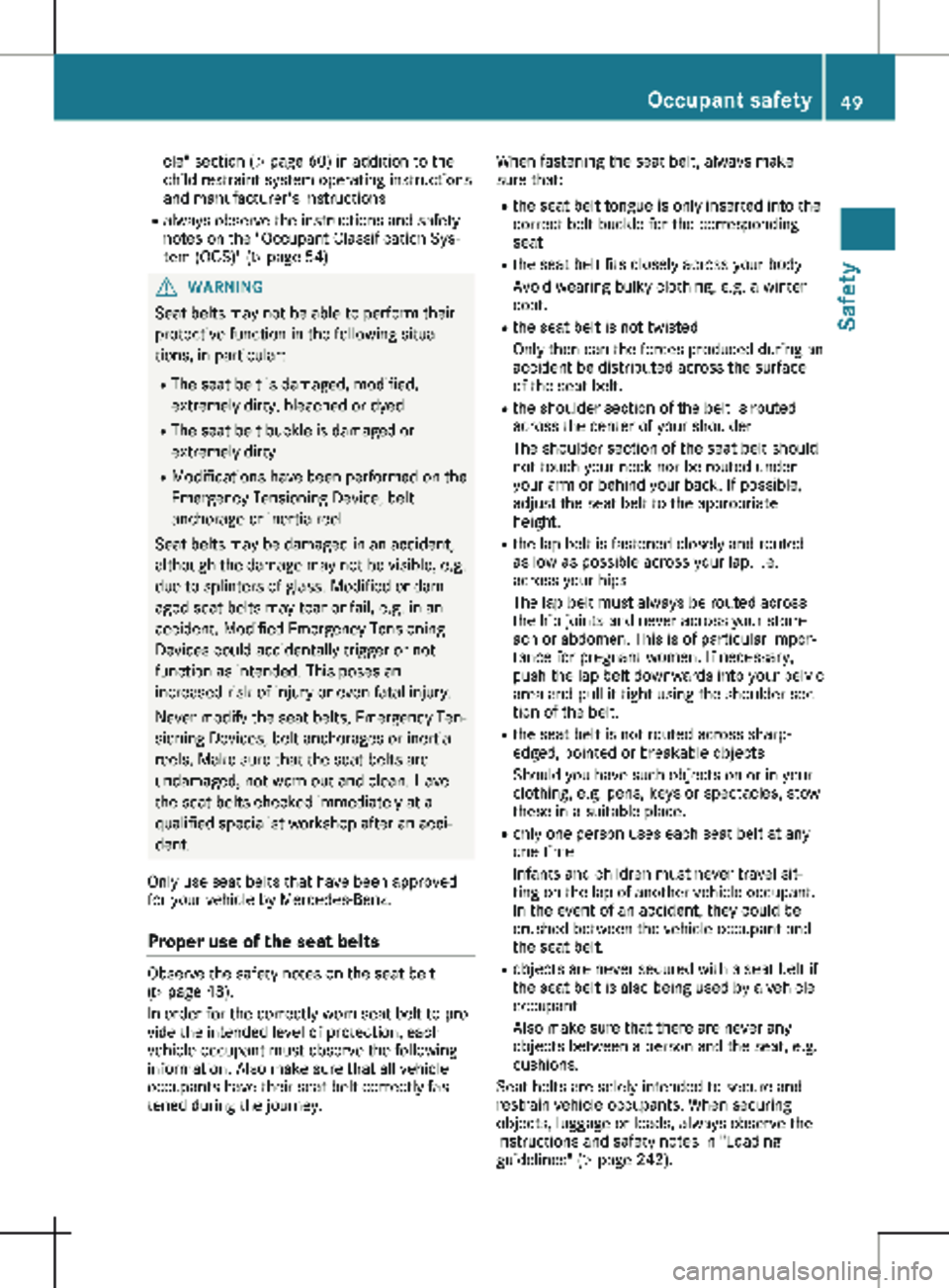
cle" section (Y page
60) in addition to the
child restraint system operating instructions
and manufacturer's instructions
R always observe the instructions and safety
notes on the "Occupant Classification Sys-
tem (OCS)" ( Y page 54)G
WARNING
Seat belts may not be able to perform their
protective function in the following situa-
tions, in particular:
R The seat belt is damaged, modified,
extremely dirty, bleached or dyed
R The seat belt buckle is damaged or
extremely dirty
R Modifications have been performed on the
Emergency Tensioning Device, belt
anchorage or inertia reel
Seat belts may be damaged in an accident,
although the damage may not be visible, e.g.
due to splinters of glass. Modified or dam-
aged seat belts may tear or fail, e.g. in an
accident. Modified Emergency Tensioning
Devices could accidentally trigger or not
function as intended. This poses an
increased risk of injury or even fatal injury.
Never modify the seat belts, Emergency Ten-
sioning Devices, belt anchorages or inertia
reels. Make sure that the seat belts are
undamaged, not worn out and clean. Have
the seat belts checked immediately at a
qualified specialist workshop after an acci-
dent.
Only use seat belts that have been approved
for your vehicle by Mercedes-Benz.
Proper use of the seat belts Observe the safety notes on the seat belt
(Y page
48).
In order for the correctly worn seat belt to pro-
vide the intended level of protection, each
vehicle occupant must observe the following
information. Also make sure that all vehicle
occupants have their seat belt correctly fas-
tened during the journey. When fastening the seat belt, always make
sure that:
R the seat belt tongue is only inserted into the
correct belt buckle for the corresponding
seat
R the seat belt fits closely across your body
Avoid wearing bulky clothing, e.g. a winter
coat.
R the seat belt is not twisted
Only then can the forces produced during an
accident be distributed across the surface
of the seat belt.
R the shoulder section of the belt is routed
across the center of your shoulder
The shoulder section of the seat belt should
not touch your neck nor be routed under
your arm or behind your back. If possible,
adjust the seat belt to the appropriate
height.
R the lap belt is fastened closely and routed
as low as possible across your lap, i.e.
across your hips
The lap belt must always be routed across
the hip joints and never across your stom-
ach or abdomen. This is of particular impor-
tance for pregnant women. If necessary,
push the lap belt downwards into your pelvic
area and pull it tight using the shoulder sec-
tion of the belt.
R the seat belt is not routed across sharp-
edged, pointed or breakable objects
Should you have such objects on or in your
clothing, e.g. pens, keys or spectacles, stow
these in a suitable place.
R only one person uses each seat belt at any
one time
Infants and children must never travel sit-
ting on the lap of another vehicle occupant.
In the event of an accident, they could be
crushed between the vehicle occupant and
the seat belt.
R objects are never secured with a seat belt if
the seat belt is also being used by a vehicle
occupant
Also make sure that there are never any
objects between a person and the seat, e.g.
cushions.
Seat belts are solely intended to secure and
restrain vehicle occupants. When securing
objects, luggage or loads, always observe the
instructions and safety notes in "Loading
guidelines"
(Y page 242). Occupant safety
49
Safety Z
Page 53 of 320
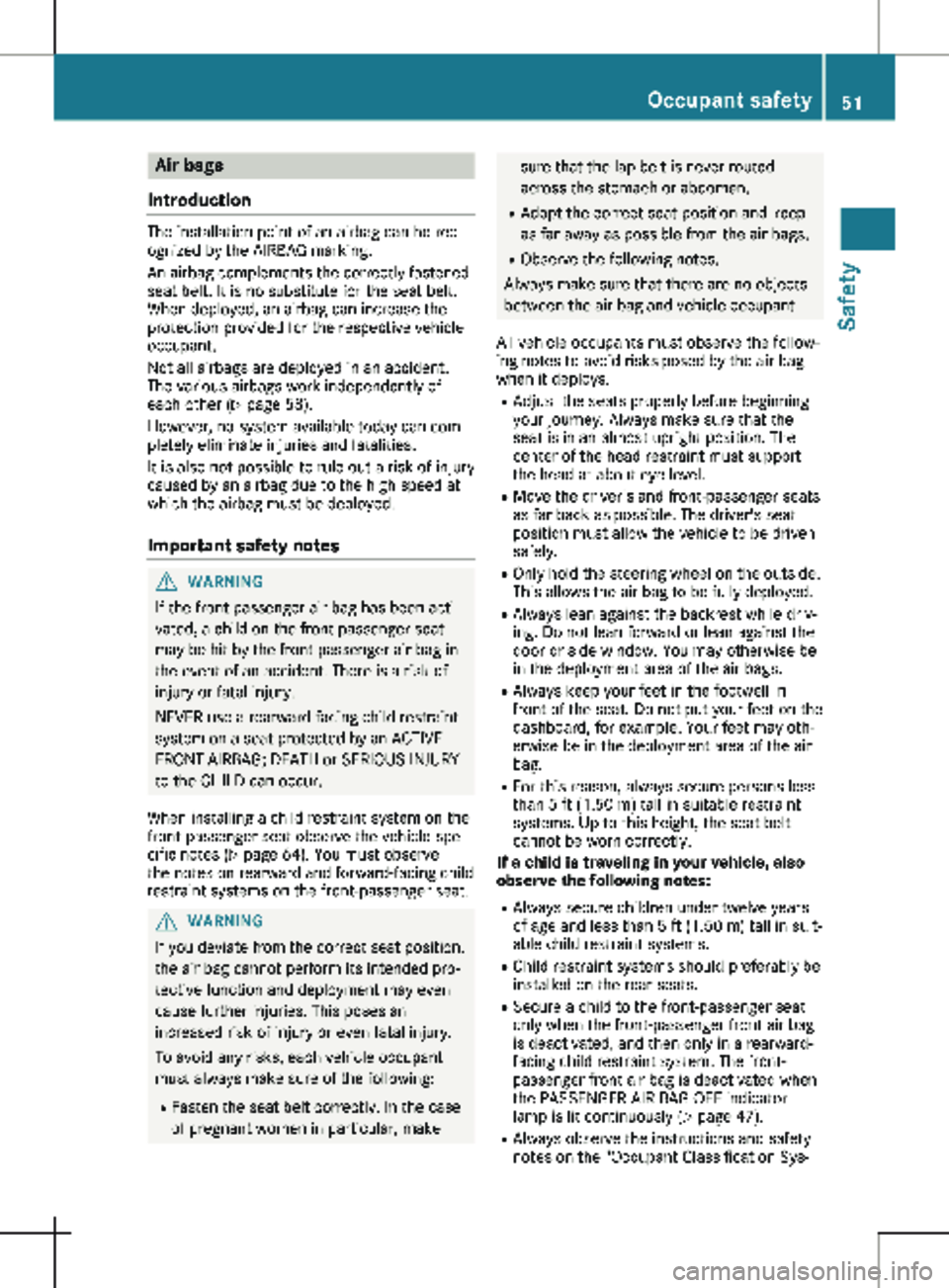
Air bags
Introduction The installation point of an airbag can be rec-
ognized by the AIRBAG marking.
An airbag complements the correctly fastened
seat belt. It is no substitute for the seat belt.
When deployed, an airbag can increase the
protection provided for the respective vehicle
occupant.
Not all airbags are deployed in an accident.
The various airbags work independently of
each other (Y page
58).
However, no system available today can com-
pletely eliminate injuries and fatalities.
It is also not possible to rule out a risk of injury
caused by an airbag due to the high speed at
which the airbag must be deployed.
Important safety notes G
WARNING
If the front passenger air bag has been acti-
vated, a child on the front passenger seat
may be hit by the front passenger air bag in
the event of an accident. There is a risk of
injury or fatal injury.
NEVER use a rearward-facing child restraint
system on a seat protected by an ACTIVE
FRONT AIRBAG; DEATH or SERIOUS INJURY
to the CHILD can occur.
When installing a child restraint system on the
front-passenger seat observe the vehicle-spe-
cific notes
(Y page 64). You must observe
the notes on rearward and forward-facing child
restraint systems on the front-passenger seat. G
WARNING
If you deviate from the correct seat position,
the air bag cannot perform its intended pro-
tective function and deployment may even
cause further injuries. This poses an
increased risk of injury or even fatal injury.
To avoid any risks, each vehicle occupant
must always make sure of the following:
R Fasten the seat belt correctly. In the case
of pregnant women in particular, make sure that the lap belt is never routed
across the stomach or abdomen.
R Adopt the correct seat position and keep
as far away as possible from the air bags.
R Observe the following notes.
Always make sure that there are no objects
between the air bag and vehicle occupant.
All vehicle occupants must observe the follow-
ing notes to avoid risks posed by the air bag
when it deploys.
R Adjust the seats properly before beginning
your journey. Always make sure that the
seat is in an almost upright position. The
center of the head restraint must support
the head at about eye level.
R Move the driver's and front-passenger seats
as far back as possible. The driver's seat
position must allow the vehicle to be driven
safely.
R Only hold the steering wheel on the outside.
This allows the air bag to be fully deployed.
R Always lean against the backrest while driv-
ing. Do not lean forward or lean against the
door or side window. You may otherwise be
in the deployment area of the air bags.
R Always keep your feet in the footwell in
front of the seat. Do not put your feet on the
dashboard, for example. Your feet may oth-
erwise be in the deployment area of the air
bag.
R For this reason, always secure persons less
than 5 ft
(1.50 m) tall in suitable restraint
systems. Up to this height, the seat belt
cannot be worn correctly.
If a child is traveling in your vehicle, also
observe the following notes:
R Always secure children under twelve years
of age and less than 5 ft (1.50 m) tall in suit-
able child restraint systems.
R Child restraint systems should preferably be
installed on the rear seats.
R Secure a child to the front-passenger seat
only when the front-passenger front air bag
is deactivated, and then only in a rearward-
facing child restraint system. The front-
passenger front air bag is deactivated when
the PASSENGER AIR BAG OFF indicator
lamp is lit continuously (Y page 47).
R Always observe the instructions and safety
notes on the "Occupant Classification Sys- Occupant safety
51
Safety Z
Page 55 of 320

tion of the occupant classification system
(OCS) could be adversely affected. This
poses an increased risk of injury or even
fatal injury.
You should only use seat covers that have
been approved for the respective seat by
Mercedes-Benz.
Side impact air bags
: deploy next to the
outer bolster of the seat backrest.
When deployed, the side impact air bag offers
additional thorax and pelvis protection. How-
ever, it does not protect the:
R head
R neck
R arms
If the restraint system control unit detects a
side impact, the side impact air bag is
deployed on the side on which the impact
occurs.
The side impact air bag on the front passenger
side deploys under the following conditions:
R the OCS system detects that the front
passenger seat is occupied or
R the seat belt buckle tongue is engaged in
the belt buckle of the front passenger seat
If the belt tongue is engaged in the belt
buckle, the side impact air bag on the front
passenger side deploys if an appropriate acci-
dent situation occurs. In this case, deployment
is independent of whether the front passenger
seat is occupied or not. Window curtain air bags
Example: window curtain air bag above the front
door
Example: window curtain air bag for all seat rows
Window curtain air bags : or ; are integra-
ted into the side of the roof frame. Window
curtain air bags for all seat rows ; deploy in
the area extending from the front door (A-pil-
lar) to the rear side window (D-pillar).
When deployed, the window curtain air bag
enhances the level of protection for the head.
However, it does not protect the chest or
arms.
If the restraint system control unit detects a
side impact, the window curtain air bag is
deployed on the side on which the impact
occurs.
If the system determines that they can offer
additional protection to that provided by the
seat belt, a window curtain air bag may be
deployed in other accident situations
(Y page
58). Occupant safety
53
Safety Z
Page 57 of 320

is disabled. It will not be deployed in the
event of an accident and cannot perform its
intended protective function. A person in the
front-passenger seat could then, for exam-
ple, come into contact with the vehicle's
interior, especially if the person is sitting too
close to the dashboard. This poses an
increased risk of injury or even fatal injury.
When the front-passenger seat is occupied,
always ensure that:
R the classification of the person in the
front-passenger seat is correct and the
front-passenger front air bag is enabled or
disabled in accordance with the person in
the front-passenger seat
R the front-passenger seat has been moved
back as far back as possible.
R the person is seated correctly.
Make sure, both before and during the jour-
ney, that the status of the front-passenger
front air bag is correct. G
WARNING
If you secure a child in a child restraint sys-
tem on the front-passenger seat and the
PASSENGER AIR BAG OFF indicator lamp is
off, the front-passenger front air bag can
deploy in the event of an accident. The child
could be struck by the air bag. This poses an
increased risk of injury or even fatal injury.
Make sure that the front-passenger front air
bag has been deactivated. The PASSENGER
AIR BAG OFF indicator lamp must be lit.
NEVER use a rearward-facing child restraint
on a seat protected by an ACTIVE FRONT
AIR BAG in front of it; DEATH or SERIOUS
INJURY to the child can occur. G
WARNING
If you secure a child in a forward-facing child
restraint system on the front-passenger seat
and you position the front-passenger seat
too close to the dashboard, the child could,
in the event of an accident:
R come into contact with the vehicle's inte-
rior if the PASSENGER AIR BAG OFF indi-
cator lamp is lit, for example
R be struck by the air bag if the
PASSENGER AIR BAG OFF indicator lamp
is off
This poses an increased risk of injury or
even fatal injury.
Move the front-passenger seat as far back
as possible. Always make sure that the
shoulder belt strap is correctly routed from
the vehicle belt sash guide to the shoulder
belt guide on the child restraint system. The
shoulder belt strap must be routed forwards
and downwards from the vehicle belt sash
guide. If necessary, adjust the vehicle belt
sash guide and the front-passenger seat
accordingly. Always observe the child
restraint system manufacturer's installation
instructions.
If OCS determines that:
R The front-passenger seat is unoccupied, the
PASSENGER AIR BAG OFF indicator lamp
lights up after the self-test and remains lit.
This indicates that the front-passenger front
air bag is deactivated.
R The front-passenger seat is occupied by a
child of up to twelve months old, in a stand-
ard child restraint system, the PASSENGER
AIR BAG OFF indicator lamp lights up after
the self-test and remains lit. This indicates
that the front-passenger front air bag is
deactivated.
But even in the case of a twelve-month-old
child, in a standard child restraint system,
the PASSENGER AIR BAG OFF indicator
lamp can go out after the self-test. This indi-
cates that the front-passenger front air bag
is enabled. The result of the classification is
dependent on, among other factors, the
child restraint system and the child's stat- Occupant safety
55Safety Z